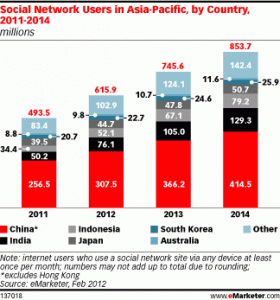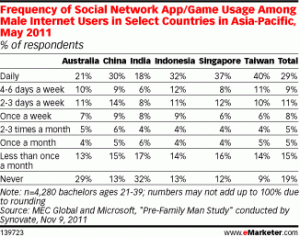APAC Round-Up: Maxifier Opens First Office in Asia & Appoints Japan Country Manager; eBay Launches geoTribes in Australia; Asia-Pacific Men Love Social Networks; India Tipped to Overtake U.S. as World's Biggest Facebook Market
by Romany Reagan on 22nd May 2012 in News


Maxifier Opens First Office in Asia & Appoints Japan Country Manager
Maxifier, a global leader in inventory revenue management technology, announced this week the establishment of its business in Asia, the opening of an office in Tokyo, and the appointment of Tomoyuki Sato as Japan Country Manager.
This news follows the appointment in February of Xiaoming Shao as Managing Director for Asia Pacific, and enables Maxifier to introduce its ADMAX inventory management and optimisation technology in Japan as well as to the wider Asian market.
Bringing more than 14 years of online experience, Sato is responsible for launching Maxifier's business in Japan and building a team that encompasses business development, account management and technical support, while establishing Japan as a hub to support other Asian regions.
Denise Colella, CFO, Maxifier, comments: “Japan offers great potential for Maxifier and we recognise it as a key market for the company. Sato has a wealth of digital experience and has been instrumental in introducing new advertising technologies into the Japanese market. Having also worked with many of the key online players in the market, he is the ideal candidate to develop our business here.”
Sato previously worked at AudienceScience in Tokyo where, as Associate Director Strategic Accounts, his responsibilities included both pre-sales activity as well as providing support for its top tier clients. He was also one of the first employees at Right Media in Tokyo when it launched its Exchange into the Japanese market in 2008, and has also worked for Overture Japan and DoubleClick Japan.
Sato adds: “Optimisation is something that is very rarely done for online campaigns in Japan. Maxifier is introducing a new technology into Japan, and one that delivers much more effective campaigns for publishers as well as agencies and their advertisers. I’m very excited about bringing this new solution to the Japanese market."
eBay Brings Offline Audience Segmentation to Online Advertising
eBay announced last week their launch of an industry-wide educational campaign and microsite to highlight the power and impact of its introduction of geoTribes, a significant industry development, where for the first time Australian marketers can target ads online based on socio economic status, lifestage and needs.
eBay’s head of advertising, JJ Eastwood, comments: “Only a company like eBay, with the ability to segment a large database according to both age and address, could provide this type of offering and implement it online at scale. Marketers who are familiar with offline geo-demographical and needs-based segmentation, but have struggled to map them to digital campaigns, now have a tool that brings offline audience segmentation to online advertising.”
“e-commerce is now a $30bn industry here in Australia and marketers are looking for opportunities to connect with consumers while they shop online. Therefore, it’s important that as we bring new advertising partners onboard, we connect them with the right audience, and in turn, our customers receive advertising messages that are both relevant and meaningful to them.
“As the leading online shopping destination in Australia with 6.9 million visitors to the site in March alone, eBay is proud to lead the market into the next phase of online advertising, retail media, and offer - what we believe is - the most robust segmentation available online.”
To illustrate the outcomes that the eBay geoTribes approach can yield, Eastwood unveiled results of rolling out the platform to existing clients in the six months since his appointment.
During the introduction phase, optimal results achieved have been four-fold increases in CTR compared with prior performance and – more importantly – clients have informed eBay that their ROI has doubled as a result of eBay’s geoTribes geo-demographic targeting. eBay states that clients who are achieving the best outcomes have followed a stepped process where they identify the correct geoTribe to target, then refine their messaging and offers to each tribe.
The microsite http://advertise.ebay.com.au/geoTribes/ illustrates the nature of each of the 15 Tribes, the accuracy of the targeting system and the reach and engagement that eBay can deliver. It incorporates an interactive tool for marketers to generate a free report based on age, gender and geographic location with social media sharing capabilities.
The company emphasised that its commitment to customer privacy remains paramount and that it maintains a strict policy of never sharing members’ personal information with third parties. Since 2007, eBay’s AdChoice program has been recognised as an industry-leading solution for providing transparency and choice in the field of behavioural targeting, with prominent notice and a persistent opt-out.
Men in Asia-Pacific Active on Social Networks
Social networks in Asia-Pacific—including those in Indonesia, Japan and China—are getting a lot of attention, and for good reason. As a whole, growth in the region has been spectacular, drawing in more users while also supporting a growing ecosystem of proven players and startups that are making applications to cater to the diverse and widespread user base.
eMarketer forecasts that base to hit 615.9 million users this year and 853.7 million in 2014.

China accounts for the bulk of users in the region, estimated to reach 307.5 million in 2012.
For service providers and marketers, young, professional men in the region are a highly desirable target. According to the November 2011 press release from Microsoft and MEC Global for their “Asia-Pacific Pre-Family Man Study,” men are avid users of social networks and increasingly using them for work, connecting with friends, and for entertainment, as their lives become focused on their career and earning money.
The survey of unmarried men ages 21 to 39 in Australia, China, India, Indonesia, Singapore and Taiwan found that they were highly engaged on social networks. Men’s activities varied across the region, but among the most popular activities were apps and social games. The survey found that 81% of respondents had used an app or game on a social network, while more than half (57%) used them at least once a week. In terms of how they accessed social networks, 70% of respondents logged on via a PC or laptop, while 25% used a smartphone.
Engagement was highest in Taiwan, Singapore, Indonesia and China.
eMarketer expects non-US social network ad revenues to total $4.09bn in 2012, accounting for 53% of the worldwide total. With the greatest number of social network users worldwide, Asia-Pacific is poised for an even larger share of total social network ad investment.
India Tipped to Overtake the U.S. to Become the World’s Biggest Facebook Market by 2015
India currently has 57 million registered Facebook members, putting it some distance behind the US (157 million) and narrowly below Brazil (59 million) — according to Socialbakers — but India has barely scratched the service of its online potential, and could bring hundreds of millions of its population online in the coming years.
Speaking to CNBC, Gartner analyst Shalini Verma predicted that a change of order will take place before the end of 2015, driven by a continued growth in mobile-based Web access:
“India could overtake the United States in the next three years. Last year, Facebook users in India doubled. Growth will be driven by mobile Internet users in second- and third-tier cities.”
Mobile is the key factor for the development of Internet access in India, which, in turn, would power Facebook and other services’ growth. Currently, fixed-line penetration is below 10% — the country passed 100 million users in November — with mobile already accounting for half of all Internet use, according to Statcounter data, and phone-based access is set to only increase.
Smartphones and Web-enabled feature phones are the driving force behind India’s online revolution. Smartphone shipments to the country passed 10 million for the first time last year, taking just ten months to set the new record, according to CyberMedia Research, but there is still much more to come.
Smartphones accounted for just 6% of the 160 million plus mobile devices that shipped to India in 2011. Shipments are very much in response and anticipation to sales and, with countrywide monthly smartphones purchases topping one million for the first time in November, retailers are set to order and sell devices in greater quantities than ever before this year.
The increasing affordability of low-end smartphones and Web-enabled feature phones is a key factor seen as having the potential to bring lower-income India’s online with a more app-centric mobile experience.
Nokia is making a particular push for the first time in the internet phone buyer market with a series of affordable feature phones, including its Asha series – which begins at $60 — while two sub-$50 phones were announced last week.
Facebook itself is also pushing its low-end offering, having added seven new Indian languages to its “Facebook For Every Phone” app, which caters to feature phones in the country.
There are also encouraging signs on the infrastructure side of things. India was a relative late adopter of 3G networks, but it already has its first commercial 4G deployment, after AirTel launched its LTE service last month.
Initially available in just two cities and via dongles only, the service will expand to cover more parts of the country in time and, once LTE-compatible device ownership swells, smartphones and tablets will be included too.
Airtel CEO Sanjay Kapoor heralded the significance of the 4G service as “driving fundamental changes in society at large” and wider adoption of mobile Web and Internet-enabled devices is likely to see Facebook, Twitter and other online services seriously grow their presence among India’s 1.2 billion population.
Facebook itself has previously admitted that India will become its biggest market at some point, but it remains to be seen if Facebook user numbers there can accelerate at such a rate that it overtakes the US by 2015.
Based on recent growth (1.96% in the last three months) — which doesn’t account for saturation — the U.S. will pass 200 million members by the end of 2015. That would require Facebook to grow by more than three and half times its current user base in India – a big task.
Currently, half of India’s Internet users are registered members of Facebook, which suggests that the demand to support such growth is there. Assuming that the site held its popularity among Indians, it could break 200 million users if the country is able to bring a further 300 million new Internet users online by 2015.
However way you look at it, the requirement is challenging but Facebook will be concerned with growing its user base (and revenues) in India, and that is certain to happen regardless of whether India tops the US market, or not.
APACAustraliaMobileSocial Media









Follow ExchangeWire